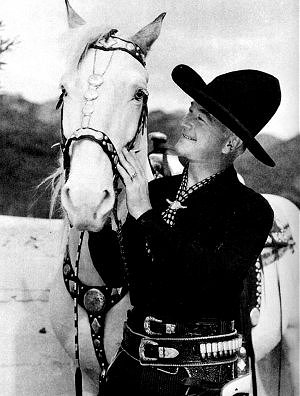1895-1972

Movie/TV Cowboy: Hopalong Cassidy was one of America’s greatest Cowboy heroes.
Originally created in novels and short stories by author Clarence E. Mulford, Hopalong Cassidy was immortalized by actor, William Boyd.
His likeness was brought to millions through movies, television, radio, novels and over 2,400 authorized merchandising items during the ‘40s and ‘50s. Boyd starred in 66 full-featured Hopalong Cassidy films, 52 half-hour television programs, and 104 radio shows. Attesting to the popularity of the western theme, at least a dozen of Mulford’s novels are still in print.
The original character created by Mulford sported a number of vices but it was Boyd who turned the cowboy into a matinee idol for the kids. His signature clothing was black with a tall hat and he rode a white horse named Topper. It was Boyd who acquired the TV rights to his movies and the first shows on TV were, in fact, edited versions of the films. He also acquired the radio and commercial rights, as a result, we have wonderful memorabilia in Hopalong Cassidy lunchboxes, pajamas, bedspreads, etc. His last film cameo was as the circus attraction, Hopalong Cassidy in Cecil B. DeMille’s “The Greatest Show on Earth”.
Biography
William Boyd was born in Ohio in 1895 and raised in the Tulsa, Oklahoma area before arriving in Hollywood around 1918. He became a leading man during the silent era, and his best work from that period included many films for director Cecil B. deMille.
Boyd brought the character of Hopalong Cassidy to the screen in a feature produced by Paramount Pictures. The studio made 34 more pictures with Bill Boyd as Hoppy and United Artists produced 31 others, also with Bill Boyd. Never in Hollywood history has one man played the same character in as many features. When audiences the world over saw the films, Bill Boyd and Hopalong Cassidy became synonymous.
Time Magazine in 1950 said, “Boyd made Hoppy a veritable Galahad of the range, a soft spoken paragon who did not smoke, drink or kiss girls, who tried to capture the rustlers instead of shooting them, and who always let the villain draw first if gunplay was inevitable.” Boyd himself said, “I played down the violence, tried to make Hoppy an admirable character and I insisted on grammatical English.” His character was well known for moseying up the bar and ordering milk.
In 1950, Boyd moved the character to television, this time with remarkable foresight. He had purchased the television rights to all the Hoppy motion pictures and licensed 52 of them to the NBC Television Network to be telecast as one hour episodes. From the moment that Hopalong Cassidy premiered on NBC, Bill Boyd became an international hero, for the films were telecast not only in America but all over the world as well.
Twelve of the remaining motion picture features that Boyd retained under the Company name, “North Vines,” were edited by him into half hour episodes. Following this move, he formed a new television production company to shoot a series of 40 new half hour episodes. The company ended up creating a total of 52 half hours for the NBC network.
William Boyd’s popularity was astounding. He received 15 thousand fan letters a week and endless requests to make public appearances. He made two worldwide tours while NBC pressed him to continue production. During public appearances, as many as a million fans turned out to see him, among them: presidents, congressmen, governors and generals. As he was in his sixties by this time, he began to feel that the Hoppy character could not be properly portrayed at this age. He was also feeling the stress of being before the cameras month after month. The year before he retired, he made 40 Hoppy episodes in as many weeks and made one more tour around the world for the Newsboys’ Association.
After that tour, he put his horse Topper out to pasture and said goodbye to his alter ego, Hopalong Cassidy. Boyd was reluctant to retire because of his loyal fans and the knowledge that his large production crew would be put out of work. Fortunately, CBS was about to start shooting the series, Gunsmoke, and Boyd was able to turn over his company to that network, assuring employment for his entire crew.
Topper is buried at the Los Angeles Pet Memorial Park in Calabasas, California. The park is called S.O.P.H.I.E. (Save Our Pets’ History in Eternity).
U. S. Television Office, Inc. the copyright proprietor of the Hopalong Cassidy Motion Picture Film Library and owner of the merchandising rights to the Hopalong Cassidy characters selected Kansas for the home of the “Hopalong Cassidy Cowboy Museum”. Among the museum’s features are displays honoring Hopalong Cassidy as well as the Chisholm Trail and other Silver Screen Cowboys.





